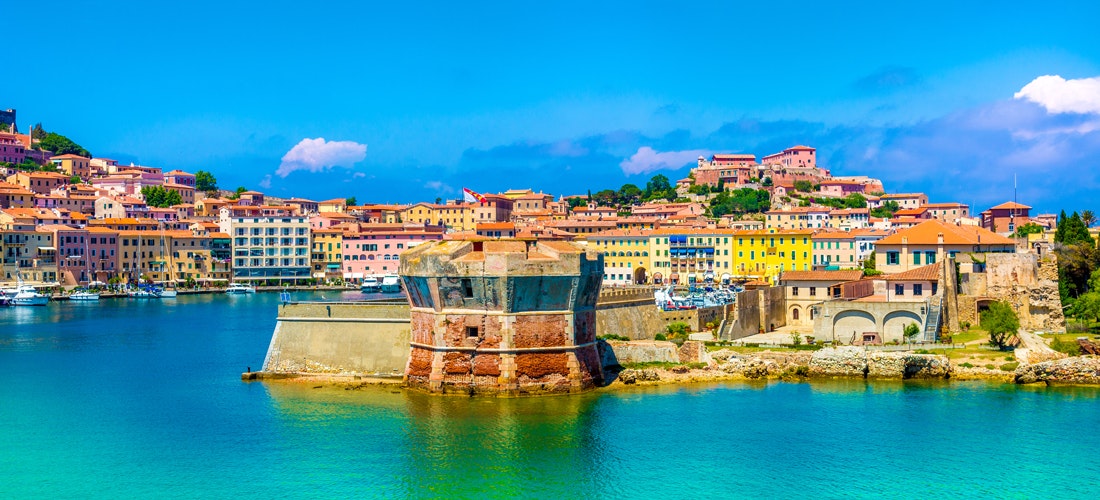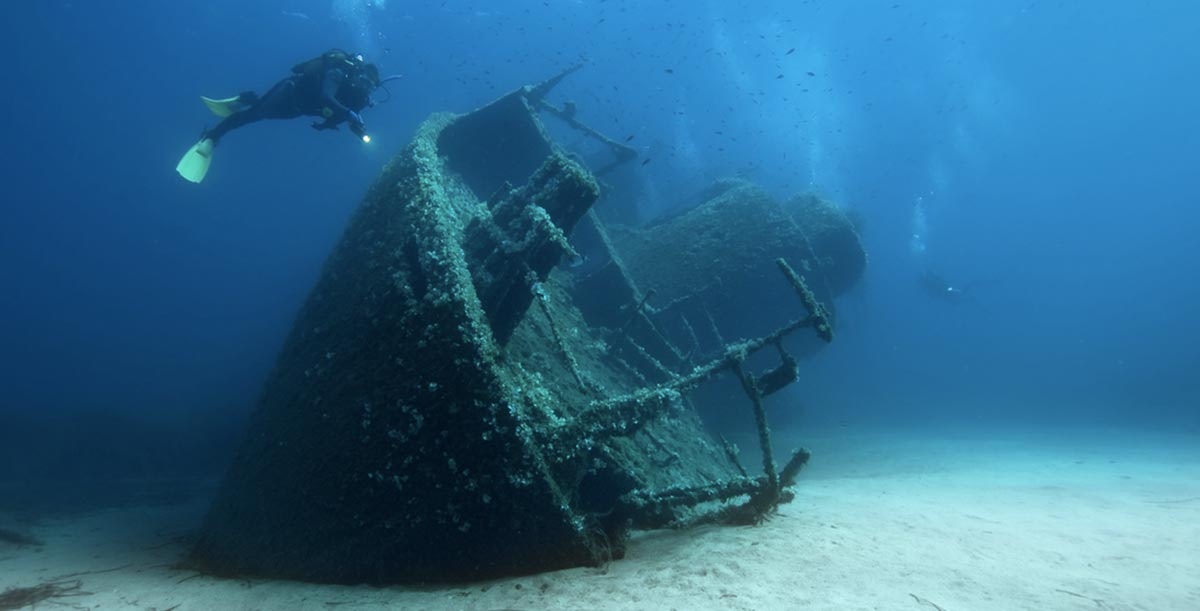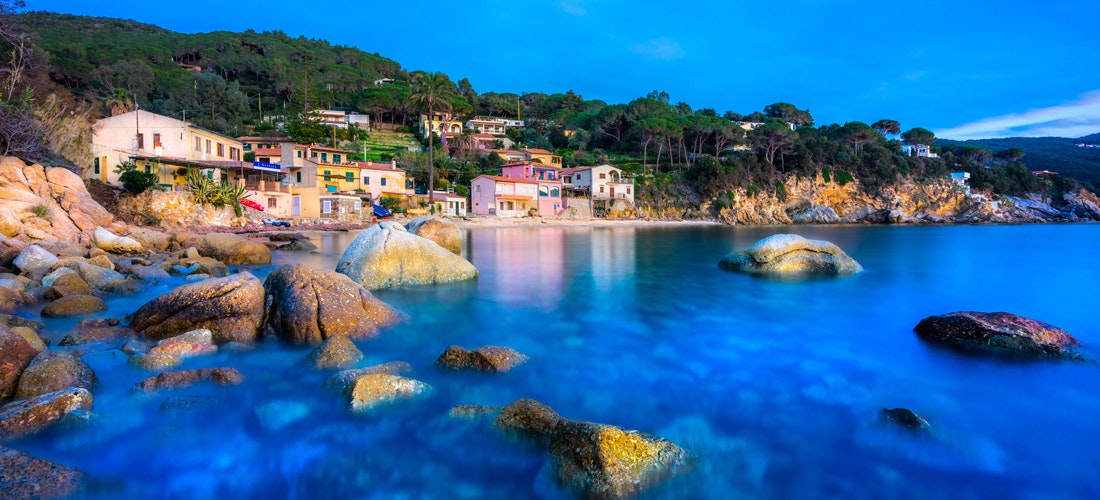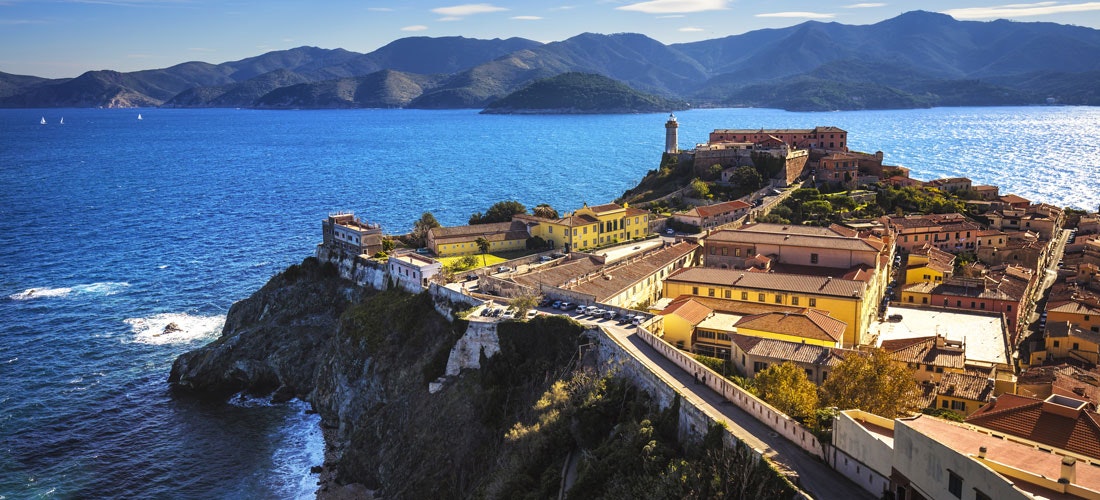On 3 May, 1814 at 18:00 local time, the British frigate Undaunted landed in the Elba harbour of Portoferraio carrying a truly rare cargo. Emperor Napoleon had been banished, to this small island situated a mere 16 km from the mainland under the Treaty of Fontainebleau and was bound to spend the rest of his hitherto-tempestuous-life in exile. And a more charming prison he could hardly choose. This is to say that many attractions have been accumulated on Elba and its surroundings over a very small area, particularly if, like Napoleon himself, you have a sailing yacht at your disposal. Its shores are filled with beautiful bays, of which there are so many that it is easy to find yourself an anchorage for the night or to have lunch. At the ends of these bays, you will almost always find a beautiful beach of snow-white sand or pleasantly massaging pebbles. The sea in the area around the shores of Elba is a deep turquoise and emerald colour and beckons you to dive in, so when you anchor, you really will have a hard time trying to keep the crew on board. Elba is a true paradise for divers. The dive to the comparitively modern wreck of L'Elviscot to the south of the island is a unique experience. If you sail around the whole of Elba, or you make a crossing to Corsica, devote a moment of your attention to the Capo San Andrea cape to the northeast of the island. This is a unique arrangement of cliffed coastline and unspoiled countryside.
Portoferraio
Portoferraio is the capital of Elba and also one of the oldest cities on the island. Its atmosphere is created by narrow lanes leading uphill which are criss-crossed with washing lines bearing fragrant and freshly washed laundry. In the ancient past, it was graced by the long-term residence of the Ligures, the Estruscans, the Greeks, and later the Romans who renamed it Fabricia. Across the gulf, opposite the city near Begnaia Bay, is a place known as La Grotta, where you can see the remains of a Roman villa with terraces and a pool. The Medici family greatly influenced the contemporary appearance of the city. Cosimo Medici commenced extensive fortification work here in 1548. There is a lot of this to see in the peninsula harbour of Portoferrario itself. Apart from the beautiful city with its old lanes on the hill, you must not miss out on a visit to Napoleon’s residence, the Villa dei Mulini with its beautiful garden and view of the island of Capraia, which is located in the highest parts of the city between the Stella and Fort Falcone fortresses. One very important mark left by Napoleon is his summer residence in Villa San Martino, which you will find about 6 km in the direction of Marina Marciana and has now been transformed into the Demidoff Art Gallery. Other monuments worthy of your attention include the Chiesa Reverenda Misericordia and the Chiesa di Santo Stefano alle Trane, the Altura Etrusca del Castiglione Fortress, and the beautiful botanical gardens in Ottone dating back to 1910, where all sorts of palms and other plants have grown accustomed to the Mediterranean climate. In San Giovanni, not far from the city, our top recommendation is a visit to the pleasant thermal spas. The exquisite Spiaggia le Viste beach is near the harbour, and further to the west, the pebbles and rocks of Le Ghiaie Bay await you. In the early evening, walk to the walls of the citadel and be amazed by a magical sunset and sea displaying a wonderful show of colours ranging from liquid red to sepia. It is hard to say why Napoleon in fact escaped from Elba.
Trattorie La Barca
At Via Francesco Guarrazzi 60, near the harbour, you will find a cosy trattoria which is frequently visited by the locals, which is always a good sign. Order some fresh seafood, grilled fish, or a large pizza. It is advisable to reserve a table.
Portoferraio Marina
If you decide to anchor for the night in Portoferraio, you would be advised to do so before 17:00. The marina fills up very quickly, particularly during summer. You can anchor here in the NW or SE part of the harbour, but the first of these quays is lined by a busy street and road and is very noisy. The right side of the harbour basin is better for an overnight stay, the left side is nearer for a tour of the city. If you visit the marina during the day, ideally you should do so in the morning as you will be able to park there free of charge for 4 hours. Showers and toilets can be found in the town hall building about 300 m from the berths and the price is about EUR 4. When sailing in, a marina employee will show you where to berth. You will find a lot of restaurants in the area around the harbour and also shops with the best prices. Another good place to stock up on provisions is Edilnautica Marina southwest of Portoferraio. There is a Co-op nearby. You can buy everything you need there, including wonderful limes to make cocktails on the boat. Be careful of the numerous ferries when sailing in.
Bagnaia Bay
If you set sail from Portoferraio on Saturday morning and want to find a nice bay with pleasant swimming, head out across the gulf towards Bagnaia Bay, which spreads out under the ruins of Volterraio castle. But be careful, entry is forbidden at the northwestern tip of the bay. You will find a lot of permanent moorings and decent shelter from the wind here, unless a W or NW wind happens to be blowing. There is a restaurant on the shore. Just 2.5 km north are the two small bays, Nisporto and Nisportino, both with nice beaches. There is a pizzeria in Nisporto.
Marciana Marina and Monte Campanne
A wise yachtsman will anchor for at least a while in the charismatic harbour town of Marciana Marina, which greets yachtsmen with its characteristic Saracen tower. And it is precisely from here that a path leads to Monte Capanne, the highest mountain on the island offering a view of the surrounding area so impressive that you will feel like Napoleon himself, if only for a moment. You can make the way down more pleasant by descending in the cable car and taking a bus the rest of the way back to the marina. This is also a great experience as the local drivers know the roads like the back of their hand and don’t take too much care with their driving. You can also do this trip from Marina di Campo on the south of the island.
Biodola
Biodola Bay, together with the peaks of Serrone delle Cime, Capannone, and Colle Pecorata, form a beautiful natural amphitheatre, skirted by a 600 m long sandy beach with emerald green seas. You anchor here at a depth of 6–8 m away from the swimming area, and on shore, you can head for one of the restaurants or bars or buy any groceries you need. There is also the smaller Scaglieri Beach in the bay. You will find Biadola Beach 8 km east of Portoferraio.
Marina di Campo
Golfo di Campo, as an amphitheatre, surrounds the attractive and very lively resort of Marina di Campo. Its harbour welcomes you with typical Pisan vigilance, manifested in the form of the Medieval Saracen tower. The harbour and small town give the impression of being inconspicuous, but they have a charm of their very own, particularly in low season. If you get up really early and walk a little way from your boat, you will meet returning fishermen and you can buy their freshly caught fish—sea bass, mackerel, bream, swordfish, tuna, and all types of seafood, and give the cook in your crew a (possibly unpleasant) surprise.
Osteria al Moro, Marina di Campo
If you want to treat your partner to a romantic evening with great food, go to this trattoria not far from the centre. You will be seated in the outside dining area or the romantic green garden, and you will be served homemade pasta and fresh fish.
The rest of the town was unfortunately badly damaged during the invasion by French troops in 1944 and its renovation was so thorough that there is not much left of the original architecture. Nevertheless, you will find some interesting places, a lot of lovely nooks and crannies and colourful Mediterranean houses. Ladies are also catered for here, with a lot of boutiques, little jewellery and clothing shops where you can even buy nice summer clothing at reasonable prices. The centre also offers a lot of shops with natural cosmetics, for example, from the San Giovanni Spa near Portoferraio.
You can shake off the stiffness of your muscles from a long sail on a lovely 6 km walk, climbing Monte Castello which is 227 m high. Apart from an impressive view of the Procchio and Golfo di Campi bays on opposite sides of the island, you will also discover the remains of an Etruscan settlement at the summit. Under the Roman paving stones there, archaeologists discovered the charred ruins of an Etruscan town which evidently failed to ward off an attack by invaders.
In Marina di Campo itself, you absolutely must visit the beautiful undersea aquarium. You will also find an airport in the city and the largest sandy beach on the island, which is still usually half empty at the start of June. Younger yachtsmen will certainly appreciate the largest and oldest discotheque in the city, Tinello on La Casina, where dancing usually goes on until the early hours. If you avoid the first line of purely tourist restaurants, you will come across little pubs, trattoria, and takeaways where the locals go to eat good food at reasonable prices. In restaurants like this, it is no problem to enjoy a meal for EUR 10 and a good pizza from a takeaway will cost around EUR 7.50. You will also find a quite surprising number of attractive ice cream gelateria and yogurt bars here.
Marina di Campo Harbour
Campo Bay allows you to anchor, but this is not recommended when stronger southerly winds are blowing. You will also find red buoys here, but do not let these fool you into thinking these are anchoring buoys. They only mark the line of the beach. If you set out in a motor boat to the shore, use the corridor marked with the white buoys NW of the harbour. The harbour itself is free of charge (at least it was at the start of June 2016), but a "bring your own anchor" system applies here. The local harbour master recommends dropping a 30–40 m anchor. Particularly when strong southerly winds are blowing, it is not advisable to anchor on the edge to the east of the breakwater by the red lighthouse, as the breakers will throw the boat around quite a bit and masts may bump into each other. In this case, it is advisable to ensure a larger gap between boats, or to draw into, or move away from the shore where possible.
Fetavaia
This bay is so beautiful that it has made it into our TOP 10 places to visit. It is relatively small, with a sandy bottom and superb hold for the anchor. You anchor here at a depth of roughly 10 m. As this is a very popular bay, it pays to get here early. There are bars and restaurants on the shore and a sports equipment rental point. Not far from here is a beautiful and very shallow dive down to the wreck of L'Elviscot.
Lacona
Lacona is a beautiful, deep bay with a sandy bottom providing great hold for the anchor even in strong winds up to 25 KN. Like many Italian bays, it may be relatively busy here during the day. It becomes empty again in the late afternoon and you will be able to enjoy the peace and quiet and some pleasant bathing by the beautiful sandy beach. Its disadvantages are limited shelter from the southerly wind and waves. Good parking is available in the northeastern corner next to the swimming buoys at a depth of between 3–7 m. A nice place to anchor and swim can be found near the beaches to the east of the bay, which are not so busy and are used occasionally by nudists.
Porto Azzurro
If anybody ever declared in the post-war period that they visited Porto Longone, it would be no exaggeration to say that this meant they were doing time in the infamous prison here. When ambitious managers later decided which town to set their sights on in the azure blue bay, the choice of course fell on Porto Azzurro.
Anchor south of the harbour, leave one capable member of the crew on board, and set out by dinghy to explore this beautiful town. You will be pleasantly surprised by the beautiful harbour square, without question the most beautiful on Elba. At its rear left corner, at the end of the first lane on the left, is a true paradise for ladies in the form of a unique workshop used to work stones with a shop attached. You can choose from dozens of meticulously crafted rings, bracelets, and necklaces here. The people of Elba know how to work some genuine miracles with stones. You will recognise the shop by the old mining cart with a display of stones in front of the entrance.
If you intend to stay in the town for a while and are interested in making a short pilgrimage, visit the Madonna di Monserrat, the most beautiful monument left by the Spanish on Elba. The former Spanish governor, Ponse y Leona was so homesick for Catalonia that he built a miniature copy of the famous Catalonian Monserrat cathedral at the end of a wildly romantic valley. Turn right about 1 km out of Porto Azzurro, on the road towards Rio nell‘ Elba.
Another point of interest is the citadel itself, dating back to 1604, which was transformed in 1858 into the previously mentioned prison. You will find it on the hill east of the harbour.

Barbarossa Bay
You will find Barbarossa Bay to the east of the citadel, about a 1.5 km above Porto Azzuro. This is a very nice, although small bay, so it pays to arrive early. You anchor here at a depth of about 13 m on a sandy bottom, where there is however, relatively little space due to the moorings and breakwaters. It offers very good shelter from northerly winds but attracts strong waves if there is a prevailing SE wind.
Laghetto di Terranera
If you fancy some unusual swimming in fresh water, sail your boat a couple of kilometres along to the coast to the fresh water lagoon, the Laghetto di Terranera with its sulphurous water. It will entrance you with its emerald green water and warm temperature, which is already much higher than that of the sea even at the start of high season. The lagoon is demarcated with signs which no longer have any writing on them, but despite this we know from our own experience that it is no problem to sail across the lagoon. On the slope not far from there, is the former Miniera di Terranera mine, where the ancient Romans very successfully mined hematite, pyrite, magnetite and limonite. If you decide to violate the ban on entry and set off for the mine, you may still find a stone or too there. There is also a beautiful view of the anchored boat, the bay and the lagoon which opens out before you from the old, half-ruined buildings around the lagoon.
The southeastern side is extremely interesting. It is lined with a large number of rusty, old mining towers, platforms, and pipes which surprisingly enrich the coastline and help create the genius juxtaposition of its location. The shadows cast by clouds over the deep, green and steep hillsides of Elba are stunningly beautiful. SW of Porto Azzurro, you will find lovely quiet beaches tucked away between the rocks.
Isolotto d' Ortano
Where the neighbouring bay is full of sailing yachts and motor boats from the Italian mainland, to the south of Isolotto d' Ortano, you can anchor in a quiet location and enjoy this attractive spot with several out-of-the-way, stony and sandy beaches and rugged rocks that enhance the charm of the place. Between the island and the mainland are shallows where you can easily get out and enjoy some nice snorkelling. But watch out for sea urchins! Seagulls nest on the island thanks to its relative remoteness and you can see their young here. But don’t hang around for too long or you will be attacked by the adults protecting their young. This is a very pleasant stop before crossing to the marina.
Rio Marina
This small harbour and even smaller town made its reputation through mining and exporting ore. And although the last iron mining operations in Rio Marina ended in 1984, the harbour cannot deny its past. Be this the paving in the streets, the facades, or the church tower, everything is covered in rusty red “make-up”. Sand containing pyrite was used for the plaster on the houses along the main street, which is lined with sycamores, and also the little, low houses around the watchtower dating back to 1534. The museum of minerals is a very interesting place and you will find it in the building of the municipal office, as is an excursion to see the former mines inland. Despite its attractiveness, this little harbour town attracts very few tourists.
You anchor in Rio Marina at the SE corner of the harbour, where there are moorings everywhere and berths provide decent shelter. Watch out for strong northerly and easterly winds.



